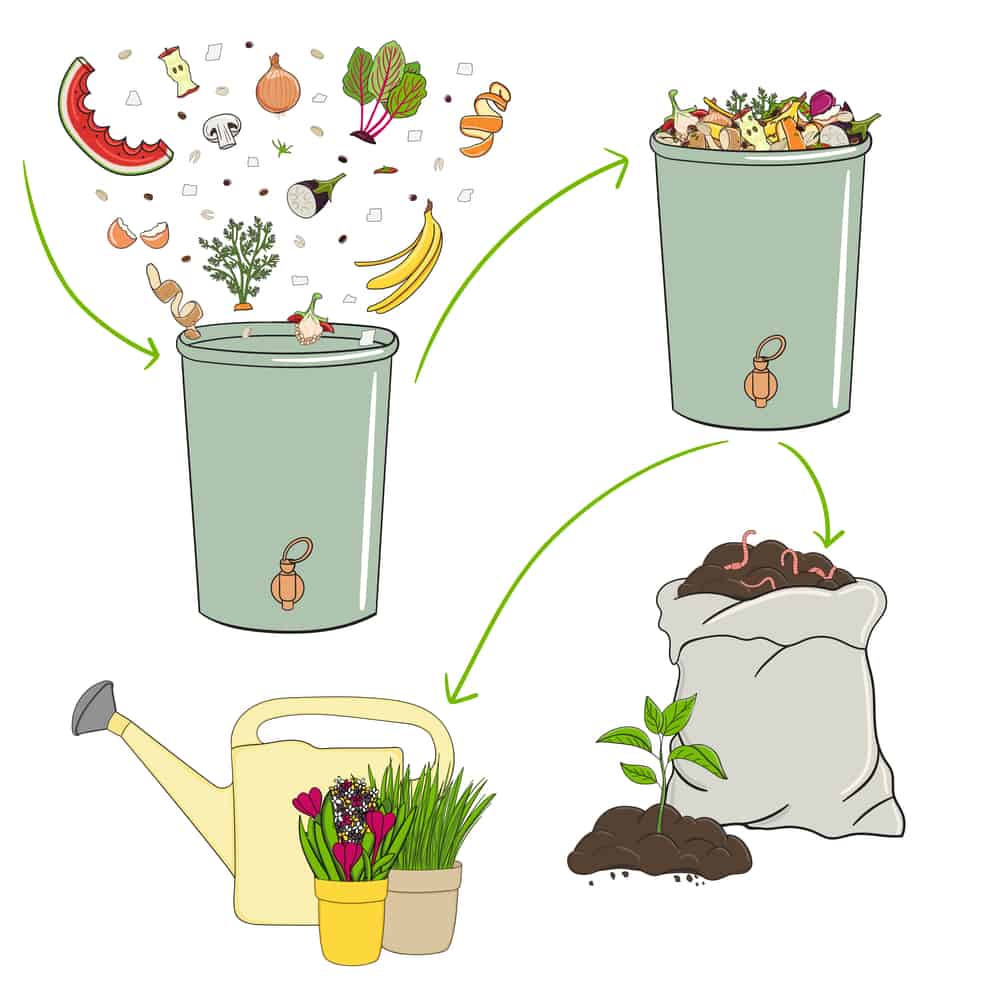Reduce. Reuse. Recycle. We’ve all heard the phrase before, but it doesn’t just refer to recycling plastic bags and keeping a compost pile in our backyard.
Did you know that gardening can also utilize this theory and be more eco-friendly?
The truth is, keeping as many items as possible out of the landfill is a goal many of us have, and zero-waste gardening is a perfect example of how we can all fit this into our daily attempts to save Mother Earth.
What Is Zero-Waste Gardening?
While roughly 75% of the items we use today can be recycled, only about 30% of them are currently going to recycling centers.
This is a huge concern here in the United States, but the numbers aren’t that different in other countries.
The definition of zero-waste gardening is easy to figure out – it simply means your garden is sustainable and you use as few items outside of the garden as possible.
Think of a garden that needs no outside purchases or products to start up or maintain.
If you can picture that in your mind, this is a zero-waste garden.
The truth is, having a garden usually means using valuable resources that might be better spent somewhere else and which usually make your garden a lot less kind to the environment.
While it may seem impossible to reduce significantly or even eliminate those resources so that your garden truly is entirely sustainable, the truth is that it’s a lot easier than you think.
Indeed, if you’d love to have a garden that is 100% sustainable and able to survive “on its own,” all you have to do is learn a few tips and recommendations from the experts.
For instance, let’s take one of those resources and look at it even closer – water. According to the experts, roughly half of today’s municipal drinking water is now being used on landscapes.
You might be thinking, but plants and gardens need to be watered regularly, and this is certainly true. But if you choose native plants, they can save on water because they have adapted to local rainfall and even the area’s temperatures, so they need less watering.
If you’re growing food, not to worry because you have a few options there, too, when it comes to saving water.
One of those options is a rain barrel, which is essentially a large barrel that allows you to catch rainwater and reuse it.
Rain barrels are covered and you place them right below the gutter downspout to catch runoff water from rainstorms.
You can then attach a hose to the barrel or use the barrel to fill up water cans.
If you choose this option, there is one thing to remember – you’ll need to check with local authorities to make sure it’s permissible to collect and use rainwater where you live.
While it should be legal everywhere according to most nature-lovers, that is not always the case, so check out the laws in your area before installing a rain barrel in your yard.
Another option is to invest in a graywater system.
This system attaches to the water system in your home and allows you to use the runoff water from bathroom sinks, showers, washing machines, and tubs (but not dishwashers, kitchen sinks, and toilets).
The runoff water goes into storage tanks and can be used for any type of outdoor watering you need done.
Just like rain barrels, you’ll have to check with local authorities to make sure it’s permissible, but it’s a great option when you’re interested in conserving as much water as possible.
What About Fertilizers and Pesticides?
You might think that gardens cannot grow and thrive without using pesticides and fertilizers, but that isn’t usually the case.
As mentioned above, native plants do much better when it comes to water usage and to pathogens as well.
Native plants have evolved and adapted to local soil and climate conditions and, therefore, the chances of needing any type of pesticide are much slimmer.
When you plant native plants, you simply may not need any pesticides at all for them to grow healthy and strong.
Foods, of course, are different from plants, and they usually do need extra nutrition.
This is where compost piles come into play.
You can save food items, garden clippings, and more, and use this to properly feed your garden so that the foods taste great and are completely organic as well.
Most of the time, you won’t run into any problems, such as diseases and pests when you’re “fertilizing” them with compost, and you can even find compost bins that are large and made out of recycled materials.
Reusing Materials as Often as Possible Is Important
When it comes to materials and supplies such as row covers, tools, and other items, think “reuse” before you automatically run out and buy something else.
Use salvaged materials when you can, and if a tree in your yard needs to be felled, turn it into chips and place it in your compost pile.
You can use old landscaping bricks or stones to make raised garden beds, and try to find secondhand tools from thrift stores, Craigslist, or even garage sales.

Of course, the tools must be durable and well-made, even if they can be bought at a discount, because you’ll want to be able to reuse them for as long as possible.
Another area of concern for most regular gardens is the use of artificial light, which is bad for the environment.
Light pollution, or the excess use of artificial light, is a big problem in the United States, but you can do things about it.
You can reduce the amount of outdoor light that you use, use dimmers whenever possible, and even use timers so that the light isn’t on 24/7.
Why is this so important? Medical experts have claimed that excessive use of artificial light can suppress the release of melatonin, which means you’ll have trouble sleeping, and even disrupt your circadian rhythm.
Too much artificial light can also disrupt nighttime bird migration and, therefore, threatens ecosystems.
In fact, there is not very much good news when it comes to artificial light and society’s dependence on it, but you can do your part by reducing your dependence on artificial light in both your home and in your garden.
The Five Rs of a Zero-Waste Garden
If you’re going to set up a zero-waste garden, you can do so more easily by remembering the five Rs of this type of garden, which include:
● Refuse whatever items you don’t need.
● Reduce whatever you do need.
● Reuse by using items you already have.
● Recycle whenever it is possible to do so.
● Rot the rest.
When it comes to taking good care of Mother Earth and trying to leave only a small carbon footprint behind, there is more you can do than you think.
While everyone’s goal should be to add nothing to the landfills each year, we all know this is impossible.
That being said, putting as little into the landfills as possible is a breeze if you make it a priority, and if you’re wondering about the advantages of having a zero-waste garden, here are just a few of them:
● The garden will be sustainable and as “green” as they come.
● You can reduce the amount of food- and land-based waste that is going into the landfill because you’ll be recycling more.
● You can reduce the number of resources you use that are usually used when growing traditional food.
● You’ll reduce the amount of plastics you’re using for packaging various garden tools and even plant food.
Zero-waste gardens reduce your consumption and save both materials and resources.
The manufacturing facilities may be a little slower if more people did this, but it will be much better in the long run in an environmentally friendly world.
Naturally, you won’t be able to avoid every purchase because you’ll need many tools and supplies when you first get started, but the more you learn about a zero-waste garden, the easier it will become to make it happen.
In fact, you might be surprised at just how easy it is to turn a standard garden into a zero-waste garden.
Conclusion
Zero-waste gardens are certainly gaining in popularity, and there is little wonder why.
For people who are serious about leaving behind a small carbon footprint, these gardens are actually one of the easiest ways to do this.
It would be best if you didn’t think of the process as an “all or nothing” process because the more you can do to follow the five Rs mentioned earlier, the closer you’ll get to a garden that truly is zero waste.
Even repairing equipment so that you can reuse it, not to mention accepting used items from friends, can go a long way in helping with a zero-waste garden – and lifestyle.
Once you get in the right mindset, in fact, you won’t be able to look at any supply or equipment the same way again, and this is a good thing.



